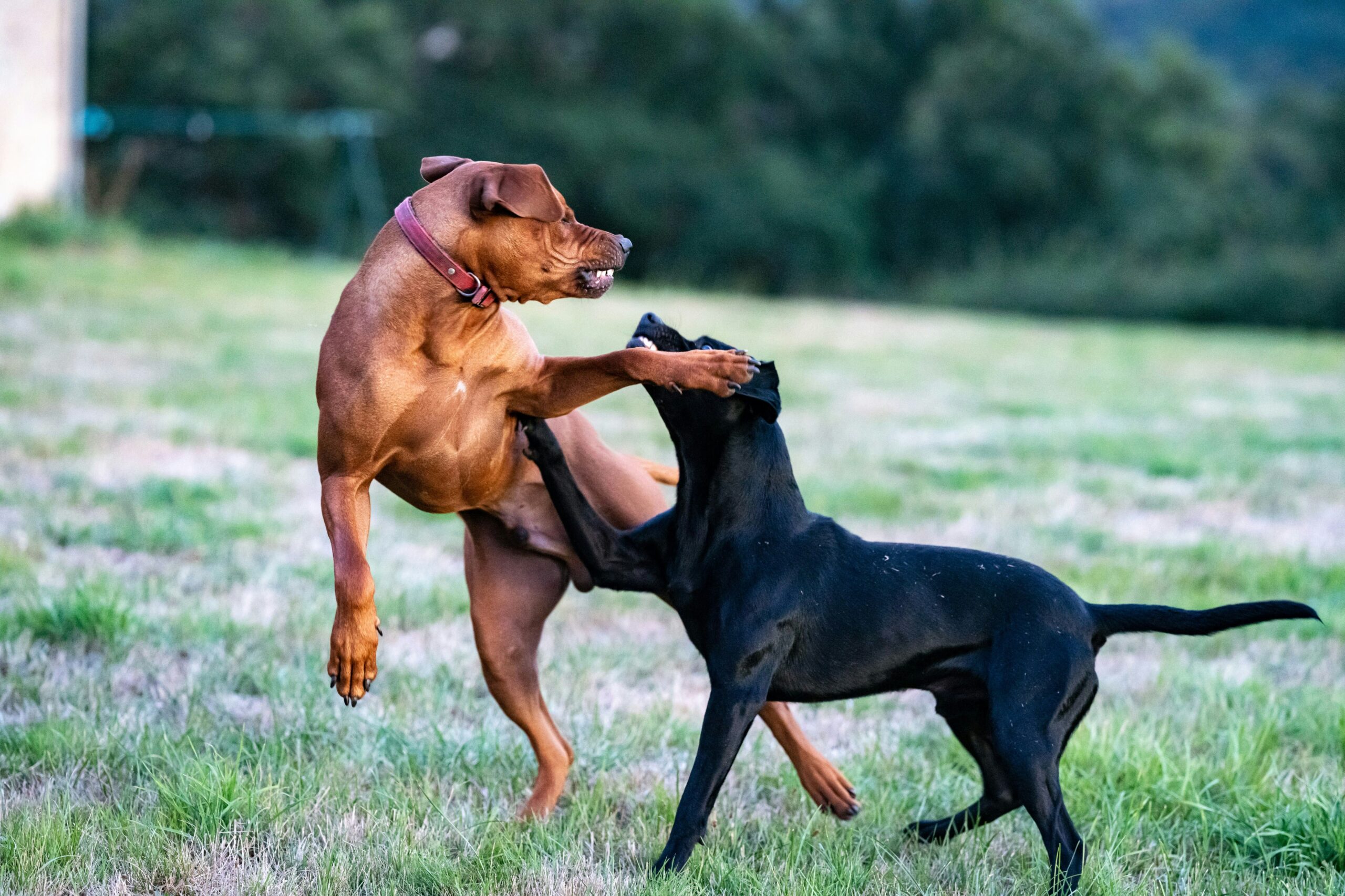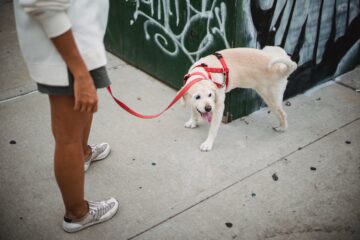Welcoming a playful puppy into a home with an older dog can bring joy and challenges.
If the spirited play fighting between your puppy and older dog is becoming a concern, fear not!
In this comprehensive guide, we’ll explore 14 expert tips on “How to Stop Puppy Play Fighting with Older Dog” to help you navigate and redirect this playful behavior, ensuring a safe and enjoyable interaction between your puppy and their seasoned companion.
As you embark on this journey, keep in mind that play fighting is a natural part of canine communication and socialization.
With the right strategies and a bit of patience, you can foster a positive relationship between your puppy and older dog while maintaining a peaceful household.
Table of Contents
14 Expert Tips on How to Stop Puppy Play Fighting with Older Dog

1] Recognize Normal Play Behavior
Understanding the subtleties of normal play behavior is fundamental.
Dogs use a variety of signals during play, such as play bows, wagging tails, and bouncy movements.
Distinguishing these playful interactions from signs of aggression involves observing body language closely.
Playful growls, loose body postures, and reciprocal engagement typically characterize normal play.
Familiarizing yourself with these cues allows you to intervene effectively if play becomes too rough, ensuring a safe and enjoyable interaction between your puppy and older dog.
2] Supervise Play Sessions
Active supervision during play sessions is essential.
Being present allows you to monitor the dynamics between your puppy and older dog closely.
It enables timely intervention if play intensifies or takes an undesirable turn.
Supervision creates a controlled environment, minimizing the risk of injuries and preventing negative associations with play.
A watchful eye helps maintain a positive and safe play experience for both dogs.
Tip: “Supervision minimizes the risk of injuries and prevents negative associations with play.”
3] Establish Clear Boundaries
Setting clear boundaries for playtime is crucial for maintaining order and preventing overstimulation.
Define specific play areas and designate certain times for play.
This structure helps your older dog have designated retreat spaces when needed, preventing overwhelming play and fostering a sense of security.
Clear boundaries contribute to a balanced play environment where both dogs feel comfortable and respected.
4] Teach Interrupt Commands
Teaching interrupt commands provides a valuable tool for managing play intensity.
Commands like “enough” or “break” act as verbal cues for both dogs to pause their play.
This interruption allows a moment to assess the situation and redirect their attention, preventing play from escalating into potential conflict.
Consistent use of interrupt commands strengthens communication and helps maintain a positive play atmosphere.
Tip: “Provide a verbal cue for both dogs to pause, preventing play from escalating into conflict.”
5] Use Positive Reinforcement
Incorporating positive reinforcement into play sessions reinforces desirable behavior.
When both dogs exhibit calm and relaxed behavior, offer praise, treats, or affection.
Positive reinforcement strengthens the association between calm behavior and positive outcomes, encouraging a peaceful and cooperative play environment.
Consistent rewards contribute to the development of positive play habits over time.
6] Provide Individual Attention
Ensuring each dog receives individual attention is crucial for preventing jealousy and competition.
Spend quality time with each dog independently to reinforce the positive bond between them and their owner.
This individual attention minimizes the likelihood of play fighting arising as a means of seeking attention, fostering a harmonious relationship between your puppy and older dog.
7] Introduce Interactive Toys
Introducing interactive toys serves as an effective strategy for redirecting playful energy.
Toys such as tug ropes or puzzle feeders engage their attention and provide an alternative outlet for play.
This not only prevents excessive roughhousing but also promotes mental stimulation, contributing to a more balanced and enjoyable play experience for both dogs.
Interactive toys are a valuable tool to redirect your dogs’ playfulness and ensure they have a positive outlet for their energy
8] Monitor Energy Levels
Understanding the energy levels of both dogs is crucial for managing play sessions effectively.
Pay attention to signs of fatigue, ensuring that play intensity and duration align with their individual needs.
Lower energy levels may require shorter, less intense play sessions, preventing irritability induced by exhaustion.
Adjusting play based on energy levels maintains a positive and enjoyable play environment.
9] Train Basic Commands
Investing time in training basic commands such as “sit,” “stay,” and “come” enhances communication and control during play.
Obedience skills provide a structured framework, allowing you to manage the behavior of both dogs effectively.
This ensures that play remains enjoyable and well-managed, promoting positive interactions between your puppy and older dog.
In the language of commands, play becomes a collaborative conversation of cooperation
10] Create Separate Rest Areas
Establishing separate rest areas for each dog is essential for promoting individual relaxation.
This designates spaces where each dog can retreat and unwind independently.
Having individual relaxation spaces reduces the likelihood of play escalating into tension and provides a sense of security for both dogs.
It fosters a harmonious living environment where each dog can enjoy moments of solitude when needed.
11] Seek Professional Guidance
Persistent play fighting or behavioral concerns may necessitate seeking guidance from a canine behavior expert.
A professional can assess the dynamics between your puppy and older dog, offering tailored strategies to address specific challenges.
Professional guidance enhances your ability to create a harmonious relationship, ensuring the well-being and positive interaction between both dogs.
• Canine behavior experts provide personalized solutions for play-related challenges. • Professional guidance ensures a comprehensive understanding of your dogs' unique dynamics.
12] Consider Age and Health
Considering the age and health of both dogs is vital when managing play sessions.
Older dogs may have physical limitations, and puppies may not be fully aware of their playmate’s capabilities.
Adjust play activities to accommodate each dog’s physical condition, preventing unintentional injuries.
Being mindful of their individual needs ensures a safe and enjoyable play experience for both your puppy and older dog.
13] Rotate Toys
Rotating toys is an effective strategy to prevent resource guarding behaviors during play.
Providing a variety of toys ensures that both dogs have access to different items, reducing the likelihood of possessiveness.
This promotes a more relaxed play environment, where both dogs can engage in play without feeling the need to compete over resources.
Tip: “Resource management contributes to a relaxed play environment and positive associations.”
14] Celebrate Calm Moments
Celebrating calm moments between your puppy and older dog is essential for reinforcing positive interactions.
Acknowledge and reward instances of relaxed behavior, whether during or after play sessions.
This positive reinforcement encourages a harmonious relationship and reinforces the idea that calm behavior is desirable.
Recognizing and celebrating these moments contributes to the overall positive dynamics between both dogs.
How to Stop Puppy Play Fighting with Older Dog: FAQs
Is play fighting normal for dogs?
Yes, play fighting is a normal behavior observed in dogs. It helps them develop social skills, exercise, and bond with each other. However, monitoring and managing play is essential to prevent potential issues.
Can play fighting escalate into aggression?
While play fighting is typically harmless, it can escalate if not managed properly. Supervision, clear boundaries, and training are crucial to prevent play from turning into aggression.
Should I intervene in every play fight?
Intervene if play becomes too rough or if one dog appears distressed. Regular intervention helps maintain control, prevents injuries, and ensures a positive play experience.
Can older dogs tolerate puppy playfulness?
Most older dogs can tolerate puppy playfulness, but individual tolerance levels vary. It’s essential to monitor their interactions and intervene if necessary to maintain a positive relationship.

Conclusion:
Effectively managing and stopping puppy play fighting with an older dog requires understanding, patience, and strategic interventions.
The 14 tips outlined in this guide provide a roadmap for creating a balanced play environment that promotes both physical and emotional well-being for your furry companions.
By consistently applying these “How to Stop Puppy Play Fighting with Older Dog” techniques, you can ensure a happy and healthy relationship between your puppy and older dog, setting the stage for years of joyful cohabitation.





